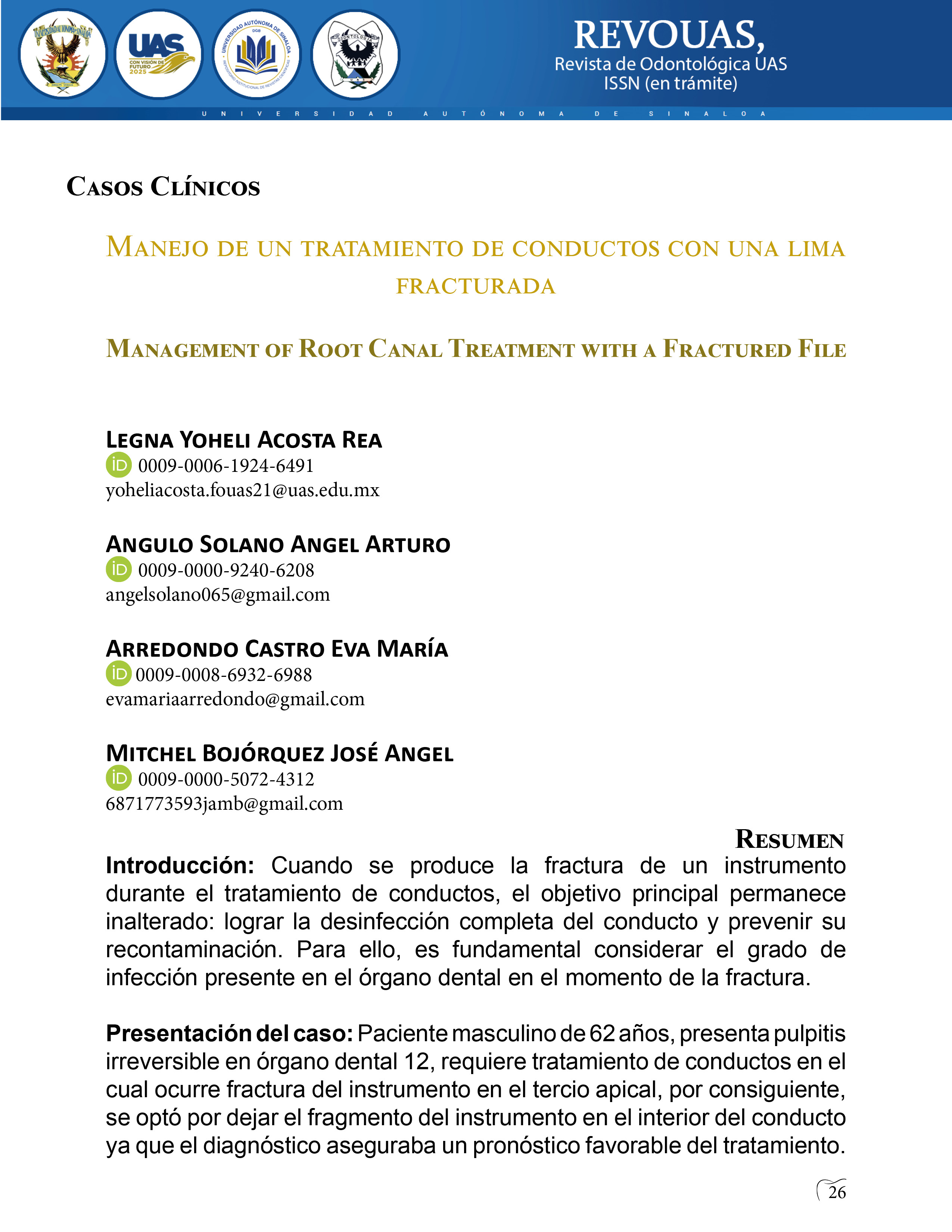Managing a root canal treatment with a fractured file
Keywords:
Fractured file, Endodontics, Infection, Irreversible pulpitis, ForecastAbstract
Abstract
Introduction: When a fractured instrument occurs, we continue to have the same objective when performing root canal treatment, which is to achieve its disinfection and avoid recontamination, so the degree of infection that the dental organ presents must be taken into account. at the time of fracture.
Case presentation: 62-year-old male patient, presents irreversible pulpitis in dental organ 12, requires root canal treatment in which fracture of the instrument occurs in the apical third, therefore, it was decided to leave the fragment of the instrument inside the canal since the diagnosis assured us a favorable prognosis for the treatment.
Discussion: Tarek and Mohsen mention that fractured instruments in endodontics before instrumentation and canal disinfection negatively affect the prognosis, while McGuigan, Louca, and Duncan confirm that if the fracture of an instrument during endodontics is performed with the proper techniques the prognosis will be favorable.
Conclusion: In our case, long-term success is predicted, since the diagnosis of irreversible vital pulp was presented and there is no infection, as well as after a year and a half, the patient is asymptomatic and without periapical pathology.
Downloads
References
Eskibağlar M, Özata MY, Ocak MS, Öztekin F. Investigación de la prevalencia de fracturas de instrumentos utilizados en tratamientos de conducto en una facultad de odontología: un estudio prospectivo. Noviembre 2023. Restor Dent Endod 2023;48(4): e38.
McGuigan MB, Louca C, Duncan HF, El impacto de los instrumentos de endodoncia fracturados. 2013, Volumen 214, No.6 pag.285-289
Mei F, Huang X, Zhang P, Hou B., Efectos de la extraccion ultrasonica de limas fracturadas del tercio medio de los conductos radiculares sobrela resistencia a la fractura radicular vertical, noviembre 2019, volumen 45, :1365-1370.
Olczack K, Grabarczyk J, Szymanski W, Estraccion de limas de endodoncia fracturadas con una tecnica de tubo: la resistencia de la articulacion pegada: configuracion de lima de endodoncia de tubo.Mayo 2023. Materiales2023, diecieseis, 4100,1-13.
Machtou P, Tomson P, Adams N, Lumley P. Influencia de los instrumentos fracturados en la tasa de éxito del tratamiento de endodoncia. Octubre 2017. :172-179
Fors UGH, Berg JO. Tratamiento endodóncico de conductos radiculares obstruidos por cuerpos extraños.Int Endo J1986;19:2-10.
Souter NJ, Messer HH. Complicaciones asociadas con la extracción de limas fracturadas mediante técnica ultrasónica.J Endo2005;31:450-452.
Chandak M, Sarangi S, Dass A, et al. (26 de septiembre de 2022) Desmitificación de las fallas detrás de instrumentos separados: una revisión. Cureus 14(9): e29588. DOI 10.7759/cureus.29588
Madarati AA, Hunter MJ, Dummer PM: Manejo de instrumentos separados intracanal. J. Endod. 2013, 39:569-81.
Tarek W, Mohsen M, Estado actual y direcciones futuras: Extracción de instrumentos fracturados, 6 de enero de 2022 -(Suplemento 3):685–709.


